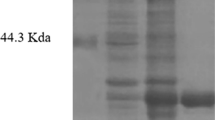Abstract
In the fermentation ofl-aspartate by a free-livingCampylobacter spec., the products formed were acetate, succinate, carbon dioxide and ammonia. The oxidative part of the fermentation pathway yielded acetate, succinate, carbon dioxide and ammonia, and the reductive part gave rise to the formation of succinate and ammonia. When grown anaerobically with aspartate, cells contained cytochromesb andc as well as menaquinone. Reduced cytochromeb, but not reduced cytochromec could be reoxidized by fumarate. In the presence of nitrate, 90% of the available electrons were transferred to nitrate, which was reduced to nitrite; the remainder was transported via the fumarate reductase system. Cells grown with aspartate and excess of formate converted aspartate quantitatively to succinate.
Similar content being viewed by others
Abbreviations
- TLC:
-
thin layer chromatography
References
Bergmeyer, H. U., Bernt, E., Pfleiderer, G.:l-Aspartat undl-Asparagin. Bestimmung mit Glutamat-Oxalacetat-Transaminase und Malat-Dehydrogenase. In: Methoden der enzymatischen Analyse (H. U. Bergmeyer, ed.) 2nd ed., pp. 1651–1654. Weinheim. Verlag Chemie 1970
Cook, R. A., Sanwal, B. D.: Isocitrate dehydrogenase fromNeurospora crassa. In: Methods in enzymology, Vol. XIII. Citric acid cycle. (J. M. Lowenstein, ed.), pp. 42–43. New York-London: Academic Press 1969
Crane, F. L., Barr, R.: Determination of ubiquinones. In: Methods in enzymology, Vol. XVII (D. B. McCormick, L. D. Wright, eds.), pp. 137–164. New York-London Academic Press 1971
Dawes, C. A., McGill, D. J., Midgley, M.: Analysis of fermentation products. In: Methods in microbiology, Vol. 6A (J. R. Norris, D. W. Ribbons, eds.), pp. 53–215. London-New York: Academic Press 1971
Dixon, G. H., Kornberg, H. L.: Assay methods for key enzymes of the glyoxylate cycle. Biochem. J.72, 3P (1959)
Harris, M. A., Reddy, C. A.: Hydrogenase activity and the H2-fumarate electron-transport system inBacteroides fragilis. J. Bacteriol.131, 922–928 (1977)
Hill, R. L., Bradshaw, R. A.: Fumarase. In: Methods in enzymology, Vol. XIII. Citric acid cycle (J. M. Lowenstein ed.), pp. 91–99. New York-London: Academic Press 1969
Hsu, R. Y., Lardy, H. A.: Malic enzyme. In: Methods in enzymology, Vol. XIII. Citric acid cycle (J. M. Lowenstein, ed.), pp. 230–231. New York-London: Academic Press 1969
Jacobs, N. J., Wolin, M. J.: Electron-transport system ofVibrio succinogenes. I. Enzymes and cytochromes of the electron-transport system. Biochim. Biophys. Acta69, 18–28 (1963a)
Jacobs, N. J., Wolin, M. J.: Electron-transport system ofVibrio succinogenes. II. Inhibition of electron-transport by 2-heptyl-4-hydroxyquinoline N-oxide. Biochim. Biophys. Acta69, 29–39 (1963b)
Kröger, A., Schimkat, M., Niedermaier, S.: Electron-transport phosphorylation to fumarate reduction in anaerobically grownProteus rettgeri. Biochim. Biophys. Acta347, 273–289 (1974)
Kröger, A., Innerhofer, A.: The function of menaquinone, covalently bound FAD and iron-sulfur protein in the electron transport from formate to fumarate ofVibrio succinogenes. Eur. J. Biochem.69, 487–495 (1976a)
Kröger, A., Innerhofer, A.: The function of the b cytochromes in the electron transport from formate to fumarate ofVibrio succinogenes. Eur. J. Biochem.69, 497–506 (1976b)
Laanbroek, H. J., Kingma, W., Veldkamp, H.: Isolation of an aspartate-fermenting, free-livingCampylobacter species. FEMS Letters1, 99–102 (1977)
Lang, E., Lang, H.: Spezifische Farbreaktion zum direkten Nachweis der Ameisensäure. Z. Anal. Chem.260, 8–10 (1972)
Lowry, O. H., Rosebrough, N. J., Farr, A. L., Randell, R. J.: Protein measurements with Folin phenol reagent. J. Biol. Chem.193, 265–275 (1951)
Miller, J. D. A., Wakerley, D. S.: Growth of sulfate-reducing bacteria by fumarate dismutation. J. Gen. Microbiol.43, 101–107 (1966)
Nawiasky, P.: Über die Umsetzung von Aminosäuren durchBac. proteus vulgaris. Arch. Hyg.66, 208–243 (1908)
Newton, N. A., Cox, G. B., Gibson, F.: The function of menaquinone (vitamin K2) inEscherichia coli, K-12. Biochim. Biophys. Acta244, 155–166 (1971)
Niekus, H. G. D., de Vries, W., Stouthamer, A. H.: The effect of different dissolved oxygen tensions on growth and enzyme activities ofCampylobacter sputorum subspecies,bubulus. J. Gen. Microbiol.103, 215–222 (1977)
Peck, H. D., Jr., Smith, O. H., Gest, H.: Comparative biochemistry of the biological reduction of fumaric acid. Biochim. Biophys. Acta25, 142–147 (1957)
Reed, L. J., Mukherjee, B. B.: α-Ketoglutarate dehydrogenase complex fromEscherichia coli. In: Methods in enzymology, Vol. XIII. Citric acid cycle (J. M. Lowenstein, ed.), pp. 55–61. New York-London: Academic Press 1969
Van 't Riet, J., Stouthamer, A. H., Planta, R. J.: Regulation of nitrate assimilation and nitrate respiration inAerobacter aerogenes. J. Bacteriol.96, 1455–1464 (1968)
Vishniac, W., Santer, M.: The thiobacilli. Bacteriol. Rev.21, 195–213 (1957)
Williams, V. R., Lartigue, D. J.: Aspartase. In: Methods in enzymology, Vol. XIII. Citric acid cycle (J. M. Lowenstein, ed.), pp. 354–362. New York-London: Academic Press 1969
Wolf, J.: Ketosäuren, Bildung von substituiertem Phenylhydrazone bzw. von substituiertem Chinoxal in Derivaten. In: Modern methods in plant analysis, Vol. II (K. Paech, M. C. Tracey, eds.), Berlin-Göttingen-Heidelberg: Springer 1955
Wong, J. C., Dyer, J. K., Tribble, J. L.: Fermentation ofl-aspartate by a saccharolytic strain ofBacteroides melaninogenicus. Appl. & Environm. Microbiol.33, 69–73 (1977)
Yoshida, A.:l-Malate dehydrogenase fromBacillus subtilis. In: Methods in enzymology, Vol. XIII. Citric acid cycle (J M. Lowenstein, ed.), pp. 141–142. New York-London: Academic Press 1969
Author information
Authors and Affiliations
Rights and permissions
About this article
Cite this article
Laanbroek, H.J., Lambers, J.T., De Vos, W.M. et al. l-Aspartate fermentation by a free-livingCampylobacter species. Arch. Microbiol. 117, 109–114 (1978). https://doi.org/10.1007/BF00689359
Received:
Issue Date:
DOI: https://doi.org/10.1007/BF00689359




